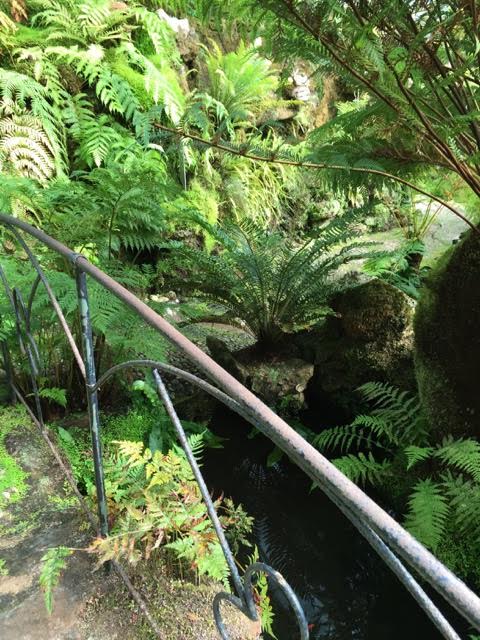Ferns in the Garden | The Enduring Gardener


22nd June 2017 • Stephanie’s Blog • Stephanie Donaldson
I find myself increasingly enamoured by ferns. They are such useful plants and once you get your eye in, you realise they have wonderfully diverse appearances. When the spring flowers and bulbs have done their stuff in the woodland area of my garden, ferns step in and provide greenery where little else will grow in the increasingly dry shade, while in the courtyard the potted ferns are surprisingly tolerant of full sun for a fair part of the day during the summer, their delicate fronds providing a cool foil for the hot colours that I like to use in this area. It’s only recently that I have begun to see ferns as interesting in their own right rather than just useful fillers, so forgive the lack of identification of early acquisitions.


Matteuccia struthiopteris in dry shade


Pot grown fern in the courtyard
Some ferns arrive unbidden – I particularly love the Hart’s Tongue (Asplenium) and Male Fern (Dryopteris filix mas) that have rooted themselves in the wall of the steps leading to the garage. Nearby a relative of the Hart’s Tongue, Asplenium scolopendrium ‘Angustifolia’ has wonderful crimped edges to the leaves and has grown happily in the same pot for the past five years. Like many of the ferns I grow, it is evergreen. It is only when I see the new fronds emerging in the spring that I cut back the old foliage and top dress the pot-grown ferns with a fresh mulch of composted bark.


Self-sown male fern and Hart’s Tongue


Asplenium scolopendrium ‘Angustifolia’
An indication of my developing addiction is the fact that I have been reading a fascinating and highly entertaining book called The Victorian Fern Craze by Sarah Whittingham (£7.95 from shirebooks.co.uk). It relates how it was actually the development of the Wardian case that led to Pteridomania (Fern Madness) sweeping through Britain in the 19th and early 20th century. The Wardian case was a portable greenhouse invented by Nathanial Bagshaw Ward – it made it possible for commercially important – as well as rare and tender plants – to be transported successfully from the colonies. Ward was also a keen naturalist and admirer of native ferns, but like other city gardeners of the time, had to contend with terrible air pollution that killed off his plants. It was the accidental inclusion of fern spores into a Wardian case and the subsequent germination in an atmosphere free of soot, but with heat, light and moisture that made it possible for Victorians to start collecting native ferns and growing them in what came to be known as terrariums – or should it be terraria?




There are only fifty species of native ferns in Britain but in the mid-19th century it was realised that they produced hundreds of variations, generally known as ‘sports’. It was seeking out these sports that fuelled the passion for collecting them. It would be no exaggeration to say that the countryside was plundered as collectors searched out something new to add to their collections. There is a report of one collector employing a labourer to dig up a 150lb prize fern and then hiring a man with a cart to transport it from Devon. For the less serious enthusiast, fern collecting was a good excuse for mixing with the opposite sex outdoors in an activity that was considered moral, healthy and educational! The First World War saw the end of Pteridomania as garden staff and knowledge were lost and progressively cleaner air meant that plants no longer needed to be kept under glass. These days both native and most introduced ferns can be grown outdoors and I am busy building my collection – of plants bought from nurseries. Never collect in the wild. Long Acre Nursery, Fibrex and Larch Cottage Nurseries all have a good range of ferns. Thus far I have resisted buying any tree ferns – I prefer to stick to native ferns. If you do buy a tree fern make sure that it is from an authorised source and that it has a tag on it to show that it hasn’t been collected from the wild.


Ferns growing in the wild in nearby Fairlight Glen


Ascog Fernery on Bute – a survivor from Victorian times
While reading this fascinating book, I was very taken with an illustration of the Victoria Lady Fern (Felix femina ‘Victoriae’) which was discovered in Scotland in 1861 and named after Queen Victoria. Its lattice-work, crisscrossing leaves (known more correctly as pinnae) sent it to the top of my ‘ferns I must acquire’ list. By remarkable coincidence, the very next day I was visiting a gardening friend and as we sat chatting in his courtyard I realised that there was a potted ‘Victoria’ right next to the table. I’m now doubly determined to get one of my own as soon as possible – it is a delicate and intriguing beauty.


Victoria Lady Fern




Coloured Lady Fern – Athyrium otophorum ‘Okahum’


Tatting Fern – Filix femina ‘Frizelliae’



